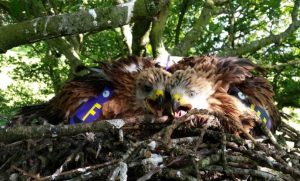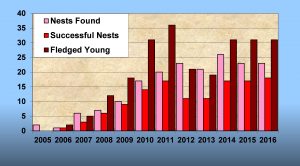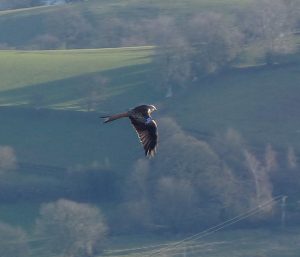Introduction
The Welsh Kite Trust and the Shropshire Raptor Study Group again tried to find the nests of all breeding pairs of Red Kite in 2016. Three major milestones have now been passed:
- Over 230 fledged young since first successful breeding in 2006
- 180 fledged young tagged in the nest
- 28 tags read on individual nesting adults
Monitoring 2016
Twenty-three nests were found, the same as last year, but access was refused to monitor one more. Only one additional pair was found, so the number of pairs found was rather less than the 31 last year and the 34 in 2014.
Some of these nests are very close together: two are only around 400 metres apart, both have been occupied for three years, and for the last two years both were successful. One of the new nests is less than 2km from another nest occupied for the last three years. Several other pairs have neighbours within thee kilometres.

© Tony Cross
Five of the nests failed, but 18 were successful (one more than last year) and, assuming that all chicks large enough to tag survived, at least 31 young fledged from them. Twenty of the fledged young from 10 nests were ringed and tagged. 2016 tags are purple with yellow letters and black bottom strip on right wing, black with yellow letters and purple bottom strip on left wing, as shown in the photo of two tagged chicks in a nest near Knighton.
In common with previous years, the high turnover of nest sites continued. Three long-standing sites occupied each year 2010-2015 were unoccupied in 2016, and four other sites used last year were also vacant. Seven were at new sites, while 20 other sites, which have had breeding Kites in earlier years, were also checked, without result.
No nests were found in the northern half of the County (the SJ ordnance survey grid squares), but there were many reports of individual birds in the north, including several in the vicinity of Telford, so breeding is expected here in the near future. The steady move eastwards was consolidated, with a nest on Wenlock Edge occupied successfully for a third year, but although several Kites were seen in the vicinity of Brown Clee and Titterstone Clee, no nests were found there.
As the population increases and spreads, nests become harder to find, so the breeding population is now undoubtedly well over the 25 pairs located, and the 31 pairs located last year.
Comparison with Previous Years
 The number of nests found is equal to the second largest number in one year since Kites returned to breed here in 2005, after an absence of 130 years, but there were more fledged young (36) in 2011, from only 20 found nests. However productivity / nest was equal to that in 2015, the highest since 2011, with 2012 and 2013 badly affected by severe weather.
The number of nests found is equal to the second largest number in one year since Kites returned to breed here in 2005, after an absence of 130 years, but there were more fledged young (36) in 2011, from only 20 found nests. However productivity / nest was equal to that in 2015, the highest since 2011, with 2012 and 2013 badly affected by severe weather.
Since the first nest was found in 2005, a total of 179 nests have been found, and 124 (69%) have been successful. Since the first successful breeding in 2006, at least 237 young are known to have flown from Shropshire nests, and 179 have been tagged. Average productivity has been 1.32 fledged young per nest found and 1.91 per successful nest. The number of nests found, successful nests and fledged young in each year is shown in the chart.
Poisoning?
In 2014, an adult was found dead on the floor directly under one nest. There were no visible signs of injury or persecution, but the landowner had used rat poison in a nearby barn, so it is likely that this caused the death of the Kite. Two well grown chicks were later found dead in the nest, presumably from the same cause. Rat poison is a common cause of death, and it is found in potentially lethal amounts in most dead Kites sent for post-mortem. The corpse of this adult was sent for post-mortem analysis, but the results have still not yet been received, 28 months later, an indication of the effect of Government cuts (“austerity”) on wildlife monitoring and resources to investigate possible breaches of the law.
Wing Tags
Six of the nesting adults in 2016 had wing tags, and five were read. Two females, one now five years old and the other four, were present at the same site as last year. Another three year old female was found nesting 7km north of her natal site near Knighton. Two more, also five and four, but sex unknown, were found for the first time. They may have been breeding at the same sites, or elsewhere, in previous years. A six year old female, tagged at the same Shropshire natal site near Knighton in 2010, was found for the first time at a nest in Wales, west of Knighton and just over 6km south of her natal site, and she too may have been at this site in previous years.
A total of 28 different tags have been read, 12 males, 12 females and four sex unknown. Males have moved an average of 17 km from their natal site, and females 15km. However, three of these (two males and a female) were long-distance colonisers from Wales in 2007 and 2008. If these three are excluded, the averages are 8km for males and 10km for females. If subsequent colonisers from Wales and the female returning to Wales are also excluded (i.e. only birds that moved within Shropshire are included) the averages are 5km for males but still 10km for females. These figures illustrate yet again how sedentary Kites are, but there is a tendency for females to move further.
The average age of first breeding is 2.5 years, and average last observed breeding is 4 years. Three have reached 7 years old. The oldest was killed by a car, early in 2015, 8years 7months 7days after ringing.

© Dawn Balmer
Several other tagged Kites have been reported during the year, including Blue E5 photographed near the Stiperstones in February. Photographers who take digital pictures of Kites are requested to blow them up and check for wing-tags. If the photo is sharp, the tag can often be read, as in this case, and such photos provide very useful information. This Kite fledged only 2km away, six years earlier in 2010.
There was a historic sighting in March, in north Holland, of a Kite tagged in a nest south of Church Stretton in 2014. It is the first ever record of a kite ringed in Wales or Shropshire by Tony Cross crossing the North Sea, out of a total of over 3,000. It was one of a brood of two, and its sibling was seen near the Stiperstones in July.
This is one of several examples of where siblings have survived for relatively long periods, or gone on to join the breeding population. The proportion of siblings at nest sites is considerably higher than would be expected by chance, indicating that some breeding pairs have much stronger genes than others, an example of natural selection at work
Winter Roost Sites
Kites often form roosts in the mid-winter months. The first roost was found near Kempton early in 2009, with up to 14 kites present, but only one tagged individual was seen at the roost on all six visits. Assuming that the turnover of tagged and untagged kites was the same, around 20 different individuals used the roost. A larger roost was found at the same site in 2010, and the tagged birds indicated that the majority were one-year-olds from Wales. The furthest travelled came over 100km, and four more came more than 50km. The roost was visited 43 times, no individual was present for as many as half the occasions, and seven out of 17 tagged individuals were only seen once. A second roost, near Wentnor, was also found in 2010. Tags suggested that most there were one-year olds from Shropshire nests. Again, knowing that individuals did not join the roost every night, and assuming that the turnover of tagged kites was the same as untagged kites, around 60 different individuals were present at the two roosts in 2010. Only three were seen at both roosts.
Subsequent attempts have been made to find winter roosts. One of up to 32 individuals was found in 2012, but the birds disappeared quickly into the wood, and no tags could be read. No regular roost site was found in the following three years, but three winter roosts were found and monitored in 2016:-
- Near Aston-on-Clun, found on 4 January with seven Kites, numbers increased rapidly and reached a maximum of 39 on 22 January, followed by a steady decline to seven again on the final visit on 16 March
- Near Norbury, found on 15 January, again rapidly increasing to 17 Kites on 23 January then a decline to five on the last visit on 3 March
- A smaller roost was found near Wentnor on 16 January, with two Kites, rising to seven on 27 January and declining to two again by the final visit on 3 March
The ratios in 2009 and 2010 suggest that the total number of Kites using the roost was double the maximum on any one night, and the 2016 count is therefore estimated at around 120 individuals, an increase of 100% on the 2010 figure. The number of tagged birds was surprisingly small, with only two at the first site and one at the third. All three roosts were at the top of a hill, so it was not possible to reach a position for reading tags, and none were actually read.
Although many nests in Shropshire are now no longer found, and tagging all the young that are found is physically impossible, it is thought that the number of tagged young is probably around 30-40% of the total one-year-olds in early 2016. Therefore the small proportion of tagged birds suggests a continuing influx from Wales, where tagging finished two years ago
The Future of Kite Tagging
It is getting increasingly difficult to tag a high proportion of the population. It has therefore been decided to continue tagging chicks in the nest for one more year, in the expectation of reaching 200 tagged young from Shropshire nests.
To ensure that as much as possible is learnt from the tagging, finding nest sites in the hope of locating tagged adults will continue until 2020, by which time Kites tagged in 2017 should have joined the breeding population.
Inter-mingling of Different Populations
The original colonisers were native Welsh birds, and there is no evidence from wing tagging that birds from the various reintroduction programmes have nested here, though a 2005 bird from near Thrapston, in Northamptonshire, was seen at a roost in February 2010 and a month later near Bucknell, and others from the Chilterns have occasionally been recorded in Shropshire Bird Reports. However, recent DNA studies (Skujina 2013) provide evidence that an adult breeding south of Clun in 2012 came from one of the reintroduced populations, possibly from Dumfries and Galloway, but originally from some of the birds introduced from Spain. The study needs to be extended before its origin can be identified with certainty (Mike Hayward pers.comm). The Kite seen in Holland was also possibly descended from one of the reintroduced populations, as those from Sweden are migratory.
If anyone knows the location of a 2016 Kite nest, or finds one in 2017, please don’t assume we know about it. Please tell Leo Smith 01694 720296, leo@leosmith.org.uk
The Red Kite Experience, Craven Arms
The Red Kite Experience at the Shropshire Hills Discovery Centre in Craven Arms started feeding in November 2014, with the aim of attracting a limited number of Kites so people can see these wonderful birds at close quarters. However, it was not until the following May that any Kites started taking food, but only a few have turned up sporadically since.
Hopefully some will start feeding over the coming winter, particularly if the winter is hard. If not, the future of the project is in doubt. . As 10 of the 25 nests found in 2016 are within 10 kilometres or so of the Centre, and there are probably others as well, and there was a winter roost of over 30 within the same distance, it is surprising that there has been so little interest. It is not likely that they are put off by the nearby town or road, given how they feed in other parts of the country, so there must be an abundance of carrion in the surrounding countryside.
Leo Smith
November 2016
Thanks to Michelle Frater, Dave Pearce and Vince Downs for helping find
and monitor the nests, to Dave Pearce for monitoring the winter roost
sites and to Tony Cross for ringing and tagging the chicks
Reference
Skujina, I. 2013. Population genetics of an endangered bird of prey: the Red Kite in Wales. A thesis submitted in partial fulfilment of the degree of Master of Philosophy, Aberystwyth University, 2013.
Return to Red Kites in Shropshire
Return to Shropshire Raptor Study Group
